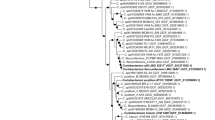Abstract
Four yeast strains (APSS 805, APSS 806, APSS 815 and AP-18) belonging to a novel Torulaspora species were isolated from coal mine soils of Singareni in Andhra Pradesh state, India. Another strain (PBA-22) was isolated from agricultural field soil from Gujarat state, India. The vegetative cells of all these strains were round, haploid and produced asci by conjugation between independent cells or mother cell and bud, with rough ascospores, suggesting their possible relation to ascomycetous yeast genus Torulaspora. Phylogenetic analysis of the D1/D2 domain of the large subunit (LSU) rRNA gene and Internal Transcribed Spacer (ITS) regions revealed that, among the five strains, three viz. APSS 805, APSS 806 and APSS 815 have identical sequences. The other two strains (AP-18 and PBA-22) differed from the other three strains in less than 1% nucleotide substitutions in the combined D1/D2 domain and ITS sequences, indicating that all of them (five strains) may belong to the same species. These five strains were closely related to Torulaspora globosa, but showed more than 3–7% sequence divergence from T. globosa and all other species in the genus Torulaspora in the combined sequence analysis of D1/D2 domain and ITS region of rRNA gene. In addition, these strains also showed distinct microsatellite finger-printing pattern from related species and differed in several physiological responses suggesting that these strains belong to a novel species of Torulaspora. We propose to name these strains as Torulaspora indica sp. nov., and designate APSS 805T = MTCC 9772 T = CBS 12408 T as the type strain of this novel species. The Mycobank number of the novel species is MB 563738.



Similar content being viewed by others
References
Altschul SF, Madden TL, Schaffer A, Zhang J, Zhang Z, Miller W, Lipman DJ (1997) Gapped BLAST and PSI-BLAST: a new generation of protein database search programs. Nucleic Acids Res 25:3389–3402
Felsenstein J (1985) Confidence limits on phylogenies: an approach using the bootstrap. Evolution 39:783–791
Kimura M (1980) A simple method for estimating evolutionary rates of base substitutions through comparative studies of nucleotide sequences. J Mol Evol 16:111–120
Kurtzman CP (2003) Phylogenetic circumscription of Saccharomyces, Kluyveromyces and other members of the Saccharomycetaceae, and the proposal of the new genera Lachancea, Nakaseomyces, Naumovia, Vanderwaltozyma and Zygotorulaspora. FEMS Yeast Res 4:233–245
Kurtzman CP (2011) Torulaspora Lindner. In: Kurtzman CP, Fell JW, Boekhout T (eds) Yeasts a taxonomic study, 5th edn. Elsevier, Amsterdam, pp 867–874
Kurtzman CP, Robnett CJ (1998) Identification and phylogeny of ascomycetous yeasts from analysis of nuclear large subunit (26S) ribosomal DNA partial sequences. Antonie van Leeuwenhoek 73:331–371
Kurtzman CP, Robnett CJ (2003) Phylogenetic relationships among yeasts of the ‘Saccharomyces complex’ determined from multigene sequence analyses. FEMS Yeast Res 3:417–432
Lodder J, Kreger-van Rij NJW (1952) The yeasts: a taxonomic study. North-Holland Publishing Co, Amsterdam
Patel MJ, Tipre DR, Dave R (2009) Isolation and identification of a Candida digboiensis strain from an extreme acid mine drainage of the Lignite Mine, Gujaratly acidic mine drainage (AMD) water sample. J Basic Microbiol 49:564–571
Perrière G, Gouy M (1996) WWW-query: an on-line retrieval system for biological sequence banks. Biochimie 78:364–369
Prasad GS, Mayilraj S, Sood N, Singh V, Biswas K, Lal B (2005) Candida digboiensis sp. nov., a novel anamorphic yeast species from an acidic tar sludge-contaminated oilfield. Int J Syst Evol Microbiol 55:967–972
Saitou N, Nei M (1987) The neighbor-joining method: a new method for reconstructing phylogenetic trees. Mol Biol Evol 4:406–425
Saluja P, Prasad GS (2007) Debaryomyces singareniensis sp.nov., a novel yeast species isolated from a coalmine soil in India. FEMS Yeast Res 7:482–488
Sood N, Patle S, Lal B (2010) Bioremediation of acidic oily sludge-contaminated soil by the novel yeast strain Candida digboiensis TERI ASN6. Environ Sci Pollut Res Int 17:603–610
Thompson JD, Gibson TJ, Plewniak F, Jeanmougin F, Higgins DG (1997) CLUSTAL_X windows interface: flexible strategies for multiple sequence alignment aided by quality analysis tools. Nucleic Acids Res 25:4876–4882
van der Walt JP (1970) Saccharomyces Meyer emend. Reess. In: Lodder J (ed) The Yeasts, ATaxonomic Study, 2nd edn. Elsevier, North-Holland, pp 555–718
van der Walt JP, Johannsen E (1975) The genus Torulaspora Lindner. Counc Sci Ind Res Res Rep Pretoria 325:1–23
Wang QM, Xu J, Wang H, Li J, Bai FY (2009) Torulaspora quercuum sp. nov. and Candida pseudohumilis sp. nov., novel yeasts from human and forest habitats. FEMS Yeast Res 9:1322–1326
White TJ, Burns T, Lee S, Taylor J (1990) Amplification and direct sequencing of fungal ribosomal RNA genes for phylogenetics. In: Innis MA, Gelfand DH, Sninsky JJ, White TJ (eds) PCR protocols. Academic Press, San Diego, pp 315–322
Yarrow D (1984) Torulaspora Lindner. In: Kreger-van Rij NJW (ed) The yeasts, a taxonomic study, 3rd edn. Elsevier, Amsterdam, pp 434–439
Yarrow D (1998) Methods for the isolation, maintenance and identification of yeasts. In: Kurtzman CP, Fell JW (eds) The yeasts, a taxonomic study, 4th edn. Elsevier, Amsterdam, pp 77–100
Acknowledgment
This study was supported by Council of Scientific and Industrial Research (CSIR), India and the Department of Biotechnology (DBT), Govt. of India, in the form a grant to the Microbial Type Culture Collection and Gene Bank (MTCC). Puja Saluja and Ravi Kumar are recipients of CSIR Senior Research Fellowships.
Author information
Authors and Affiliations
Corresponding author
Rights and permissions
About this article
Cite this article
Saluja, P., Yelchuri, R.K., Sohal, S.K. et al. Torulaspora indica a novel yeast species isolated from coal mine soils. Antonie van Leeuwenhoek 101, 733–742 (2012). https://doi.org/10.1007/s10482-011-9687-6
Received:
Accepted:
Published:
Issue Date:
DOI: https://doi.org/10.1007/s10482-011-9687-6




